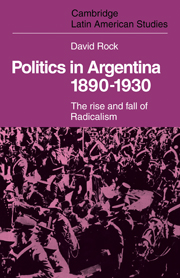Book contents
- Frontmatter
- Contents
- Preface
- 1 The components of Argentine society, 1890–1914
- 2 The oligarchy and institutional reform, 1880–1916
- 3 The rise of Radicalism, 1891–1916
- 4 The workers and their politics in Buenos Aires, 1890–1916
- 5 The first Radical government, 1916–22
- 6 The strikes, 1916–18
- 7 The Semana Trágica
- 8 1919
- 9 Postscript to the first presidency, 1920–2
- 10 The Alvear interlude, 1922–8
- 11 Yrigoyen's second presidency, 1928–30
- 12 Perspectives
- APPENDIXES
- 1 The occupational and class structure of the male population of the city of Buenos Aires by nationality, 1914
- 2 The rise of Radicalism – an historiographical note
- 3 The first Radical government and the Argentine Rural Society
- 4 The working class vote for the Radical and yrigoyenista parties in selected areas of Buenos Aires, 1912–30
- Select bibliography
- Index
9 - Postscript to the first presidency, 1920–2
Published online by Cambridge University Press: 04 August 2010
- Frontmatter
- Contents
- Preface
- 1 The components of Argentine society, 1890–1914
- 2 The oligarchy and institutional reform, 1880–1916
- 3 The rise of Radicalism, 1891–1916
- 4 The workers and their politics in Buenos Aires, 1890–1916
- 5 The first Radical government, 1916–22
- 6 The strikes, 1916–18
- 7 The Semana Trágica
- 8 1919
- 9 Postscript to the first presidency, 1920–2
- 10 The Alvear interlude, 1922–8
- 11 Yrigoyen's second presidency, 1928–30
- 12 Perspectives
- APPENDIXES
- 1 The occupational and class structure of the male population of the city of Buenos Aires by nationality, 1914
- 2 The rise of Radicalism – an historiographical note
- 3 The first Radical government and the Argentine Rural Society
- 4 The working class vote for the Radical and yrigoyenista parties in selected areas of Buenos Aires, 1912–30
- Select bibliography
- Index
Summary
The Great Collect was a final sign of the resurgence of the conservative elite groups in 1919. By the middle of the year they had established an iron grip over the Radical government. During the government's last two and a half years there were few of the dramatic events of the past, and generally it was spared the recurrent tortuous decisions which had been the source of so much danger to it before. In its relations with foreign capital the government continued to be extremely careful, and only adopted a critical line when it was absolutely sure of local support. There were a large number of petty disputes with the railway and tramway companies over fares and tariffs, but these did not lead to any basic conflicts. In several cases the railway companies won concessions they had been struggling to achieve for years. Among them was the clarification of the question of their liabilities to municipal rates for lighting and cleaning services. A measure exempting them from these was finally passed by Congress in August 1919.
In these years the Radical government became largely what the conservatives had planned it to be in 1912 – a static pliant instrument, whose only positive attribute lay in its ability to win a certain degree of popular acceptability. In 1920 and 1921 the government largely concentrated on restoring its electoral position with the middle class groups in the federal capital by its use of patronage, and in the provinces outside by means of federal interventions.
- Type
- Chapter
- Information
- Politics in Argentina, 1890–1930The Rise and Fall of Radicalism, pp. 201 - 217Publisher: Cambridge University PressPrint publication year: 1975

